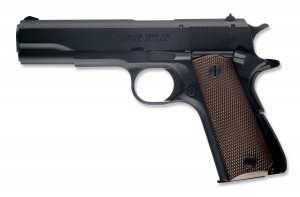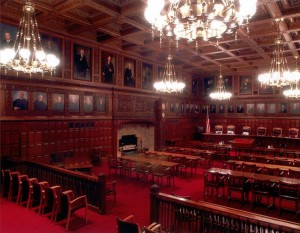People v Nelson
2016 NY Slip Op 02554
New York Court of Appeals
Decided on: April 5, 2016
Issue: Whether defendant was deprived his right to a fair trial when the victim’s family members wore T-shirts with an image of the deceased victim in an attempt to influence the jury.
Holding: The Court of Appeals held that although the trial court should have taken action when defense counsel objected to T-shirts worn by certain spectators that bore a photograph of the deceased victim, defendant was not deprived of a fair trial.
The Court of Appeals held that the United States Supreme Court has declined to create a federal standard for evaluation of spectator conduct claims. In Carey v Musladin, 549 US 70 [2006], the Supreme Court held that the effect on a defendant’s fair trial rights of spectator conduct is an open question in their jurisprudence. The Court reasoned that the test it had established in Estelle v Williams, 425 US 501 [1976] and Holbrook v Flynn, 475 US 560 [1986] for the effect of potentially prejudicial courtroom practices on defendant’s fair trial rights whether the practice presents an unacceptable risk of impermissible factors coming into play had been applied only to state-sponsored courtroom practices, Musladin, 549 US at 75-76. The Supreme Court observed that it had never applied the Williams and Flynn framework to spectator conduct. In other words, the Supreme Court left resolution spectator conduct issue to the state courts.
Facts: Defendant’s conviction stems from the shooting of two roommates, Mark Maldonado and Leo Walton. Maldonado testified at trial that defendant was angry with him because after defendant and Maldonado had been arrested together for shoplifting, Maldonado was released on bail, but defendant remained in jail for several months. On March 20, 2008, defendant asked Maldonado if he could stay the night at Maldonados apartment and Maldonado agreed. When they arrived to the apartment, Maldonado’s roommate Walton was there. Approximately after 15 minutes when Maldonado went into his bedroom he heard three gunshots and Defendant kicked the bedroom door and shot Maldonado. Defendant than fled the apartment.
Walton had died from his injuries of being shot in the back of the head but Maldonado survived after receiving medical treatment. The People’s proffered motive at trial was that defendant shot Maldonado over his anger at being in jail and killed Walton to eliminate a witness. Defendant was apprehended two days later and gave oral, written, and videotaped statements to the police. Defendant stated that once they arrived at Maldonado’s place, Maldonado fired multiple shots at defendant with a .22 caliber handgun, but defendant ducked, and the shots hit Walton instead. According to defendant, he then got up from the floor, pulled from his waistband the .380 caliber handgun he was carrying, and fired at Maldonado.
At trial, defendant raised a justification defense but the People presented evidence at trial, however, that was inconsistent with that defense. According to that evidence, the bullets recovered from the bodies of Walton and Maldonado, as well as the bullets found at the scene were all fired from a .22 caliber handgun and all shell casings found at the scene matched the same .22 caliber handgun.
On the last day of trial, after defense counsel’s summation, counsel asked for a side bar and noted that three members of Waltons family who were observing the trial were wearing T-shirts bearing Waltons photograph and the phrase “Remembering Leo Walton.” Counsel asked that the spectators be required to change their shirts and argued that they were trying to inflame or influence the jury. The prosecutor opposed the request and the court refused to instruct Walton’s family members to remove their shirts. The court noted that the spectators were seated quietly and had not drawn attention to themselves or their shirts. The court also stated that Walton’s family members had worn the shirts on previous occasions during the trial but that counsel had not brought the shirts to the court’s attention or requested any relief on those dates. When counsel protested that the shirts had not been worn before that day, the court found as a matter of fact that one of the females had worn the same shirt for at least three court dates. The jury found defendant guilty of murder in the second degree and assault in the first degree. Before sentencing, defendant moved pursuant to CPL 330.30 to set aside the verdict, arguing that by wearing the T-shirts, Walton’s family members had attempted to improperly influence the jury but the court denied that motion.
The Appellate Division affirmed and declined to create a per se rule requiring reversal whenever a spectator brings a depiction of a deceased victim into a courtroom because each particular instance of challenged conduct calls for a sui generis determination of its potential effect on the jury, made in light of the particular circumstances of the case. The court held that under particular circumstances of the case, the trial court’s determination that the spectator conduct did not threaten the ability of the jury to remain impartial was not error. A dissenting justice granted leave to appeal to the Court of Appeals where the Court of Appeals affirmed the order of the Appellate Division.
Legal Analysis: The Court of Appeals held that trial courts have the inherent authority and the affirmative obligation to control conduct and decorum in the courtroom, in order to promote the fair administration of justice for all, Matter of Katz v Murtagh, 28 NY2d 234, 238-240[1971]; People v Mendola, 2 NY2d 270, 276 [1957]; People v Jelke, 308 NY 56, 63 [1954]; 22 NYCRR 100.3 [b][2].
 Furthermore, one accused of a crime is entitled to have his guilt or innocence determined solely on the basis of the evidence introduced at trial, Taylor v Kentucky, 436 US 478, 485, [1978]. It is the duty of the trial court to protect the defendant’s right to a fair trial and to ensure that spectator conduct does not impair that right, regardless of whether defense counsel has noticed or objected to such conduct.
Furthermore, one accused of a crime is entitled to have his guilt or innocence determined solely on the basis of the evidence introduced at trial, Taylor v Kentucky, 436 US 478, 485, [1978]. It is the duty of the trial court to protect the defendant’s right to a fair trial and to ensure that spectator conduct does not impair that right, regardless of whether defense counsel has noticed or objected to such conduct.
Nevertheless, even where the trial court has an affirmative obligation to take certain action in order to protect a fundamental constitutional right, we have required defendants to preserve any alleged error for appellate review, People v Alvarez, 20 NY3d 75, 80-81 [2012], cert denied 133 S Ct 2004 [2013] and cert denied sub nom George v New York, 133 S CT 1736 [2013]. Application of the preservation rule to spectator conduct provides the trial court with a timely opportunity to correct a problem of which it may not be aware, and also facilitates appellate review of any alleged error, inasmuch as spectator conduct often will not appear on the record.
Here, defense counsel did not move for a mistrial upon learning that the spectators had worn the shirts on previous occasions, or otherwise argue that the trial court should have taken action sua sponte, cf. id. at 79, 81. This part of defendant’s appellate contention therefore is unpreserved for the Court of Appeals review. Defendant did partially preserve his contention for appellate review, however, by objecting to the shirt during summations and requesting that the trial court take action. The Court held that they therefore would review only that part of defendant’s contention.
The Court of Appeals held that the United States Supreme Court has declined to create a federal standard for evaluation of spectator conduct claims. In Carey v Musladin, 549 US 70 [2006], the Supreme Court held that the effect on a defendant’s fair trial rights of spectator conduct is an open question in their jurisprudence. The Court reasoned that the test it had established in Estelle v Willaims, 425 US 501 [1976] and Holbrook v Flynn, 475 US 560 [1986] for the effect of potentially prejudicial courtroom practices on defendant’s fair trial rights, whether the practice presents an unacceptable risk of impermissible factors coming into play had been applied only to state-sponsored courtroom practices, Musladin, 549 US at 75-76. The Supreme Court observed that it had never applied the Williams and Flynn framework to spectator conduct. In other words, the Supreme Court left resolution spectator conduct issue to the state courts.
As the Supreme Court recognized in Musladin, reflecting the lack of guidance from that Court, lower courts have diverged widely in their treatment of defendants spectator conduct claims. Some courts have applied the Williams and Flynn framework to claims that spectator conduct deprived defendant of a fair trial, United States v Framer, 585 F3d 131, 150 [2d Cir. 2009], cert denied 559 US 1058 [2010]; Norris v Risley, 918 F2d 828, 830-834 [9th Cir. 1990]; Overstreet v State, 877 NE2d 144, 158-159 [Ind 2007], cert denied 555 US 972 [2008]; State v Lord, 161 Wash 2d 276,289-290, 165 P3d 1251, 1258-1259 [2007]. Despite these methods, the common thread in these cases is that courts have refused to apply any per se rule of reversal to spectator conduct. They have consistently declined to hold that any particular category of spectator conduct is so inherently prejudicial that necessarily deprives the defendant of a fair trial. Even those courts that have relied upon Williams/Flynn framework have evaluated the particular circumstances of each case in determining whether the spectator conduct was so inherently prejudicial as to deprive the defendant of a fair trial, Framer, 585 F3d at 149-150; Norris, 918 F2d at 831-832; Overstreet, 877 NE2d at 158-159; Lord, 161 Wash 2d at 289-291, 165 P3d at 1258-1259.
Whether the trial court should intervene, and what intervention is appropriate, must depend upon the facts and circumstances of each particular case. The trial court may consider such facts such as: the particular nature of the spectator conduct at issue; how many spectators are involved; the duration of the conduct; whether the involved spectators have called attention to themselves in some way; where the spectators are seated in the courtroom; whether the jury can see or did the see the spectator conduct whether the involved spectators are part of some recognizable organization or group; whether the spectator conduct is the result of some intentional effect to influence the jury or merely an unintended display of emotion; and whether intervention will correct an ongoing problem or will simply serve to highlight a brief instance of misconduct for the jury. The list is not exhaustive inasmuch as the Court of Appeals will not presume to anticipate all of the various forms of spectator conduct that may occur during any given trial.
If the trial court decides to act, appropriate intervention may include such actions as a curative instruction to the jury, ordering the spectators to remove the display, removal of the offending spectators from the courtroom, or questioning of the jurors to determine whether they were influenced by the spectator conduct. If the trial court determines, in its discretion, that the spectator conduct was so prejudicial that no other form of curative action can ensure the defendant’s right to a fair trial, then a mistrial will be warranted. The appropriate action will, of course, be informed by any request from counsel. In deciding whether to intervene and what intervention is appropriate, the trial court’s paramount concerns must be the protection of the defendant’s fundamental right to a fair trial and the court’s obligation to preserve order and decorum in the courtroom.
Appellate courts evaluating a defendant’s contention that the trial court erred in refusing to intervene in spectator conduct, or did not intervene appropriately, should review the trial court’s action or inaction for abuse of discretion. The trial court is best situated to take all the circumstances into account and to determine the appropriate intervention, People v Ming Li, 91 NY2d 913, 917 [1998]; Matter of Plummer v Rothwax, 63 NY2d 243, 250[1984]. One factor the trial court should not consider, however, in deciding whether and how to intervene in spectator conduct, is any First Amendment rights of the spectators themselves. The Court of Appeals held that the court is not a public hall for the expression of views, nor is it a political arena or a street. It is a place for trial of defined issues in accordance with law and rules of evidence, with standards of demeanor for court, jurors, parties, witnesses and counsel. All others are absolutely silent nonfactors with the right only to use their eyes and ears, Katz v Murtagh 28 NY2d at 240.
An issue in this case: spectator displays of a deceased victim’s photograph. The Court of Appeals held that portraits or photographs of a deceased victim, taken while the victim was alive, are generally admissible at trial unless relevant to a material fact to be proven at trial, People v Stevens, 76 NY2d 833,835 [1990]. This is because such photographs may arouse the jury’s emotions. A similar risk is presented by images of a deceased victim displayed by spectators in the courtroom, either on their clothing or by some other method. Such depictions may be viewed by the jury as an appeal to sympathy for the deceased victim and the spectators wearing the display, perhaps as a request to hold the defendant responsible for their loss, Musladin, 549, US at 83; Meghan E. Lind, Hearts on Their Sleeves; Symbolic Displays of Emotion by Spectators in Criminal Trials, 98 J Crim L & Criminology 1147, 1153-1154 [2008]. The Court of Appeals held that they therefore conclude that spectator displays of a deceased victim’s portrait or?photograph should be prohibited in the courtroom during trial. Here, the trial court erred in failing to instruct the spectators to remove the shirts or cover them upon defense counsel’s objection.
Nevertheless, the Court of Appeals held that they agree with the Appellate Division that a per se rule requiring reversal whenever a spectator displays a photograph of a deceased victim during trial is untenable, Nelson, 125 AD3d at 63; id at 67-68. The Court further held that they decline to apply the Williams and Flynn framework to hold that such displays are necessarily so inherently prejudicial that they require reversal and a new trial in every case, Musladin, 549 US at 75-76. That framework, at least as traditionally applied, suggests that certain courtroom conduct is so inherently prejudicial that it requires reversal and a new trial whenever such conduct occurs during trial, Williams, 425 US at 504-505. That framework presumes both that there was error and that the error cannot be harmless because defendant has been deprived of a fair trial thereby, People v Crimmins, 36 NY2d 230, 238 [1975].
 The Court of Appeals concluded, however, that although spectator displays depicting a deceased victim should be prohibited in the courtroom during trial, and although the trial court here erred in refusing to intervene upon defense counsel’s request, the error is subject to harmless error analysis. Defendant contends that the deprivation of his right to a fair trial can never be considered harmless. The Court of Appeals held that they agree only insofar as there can be no harmless error analysis if an appellate court concludes that spectator misconduct was so egregious and the trial court’s response so inadequate that the defendant was deprived of a fair trial. Where there has been such error of a trial court or such other wrong as to have operated to deny any individual defendant his fundamental right to a fair trial, the reviewing court must reverse the conviction and grant a new trial, without regard to whether the proof of guilt was overwhelming or whether the errors contributed to the defendant’s conviction, Crimmins, 36 NY2d at 238.
The Court of Appeals concluded, however, that although spectator displays depicting a deceased victim should be prohibited in the courtroom during trial, and although the trial court here erred in refusing to intervene upon defense counsel’s request, the error is subject to harmless error analysis. Defendant contends that the deprivation of his right to a fair trial can never be considered harmless. The Court of Appeals held that they agree only insofar as there can be no harmless error analysis if an appellate court concludes that spectator misconduct was so egregious and the trial court’s response so inadequate that the defendant was deprived of a fair trial. Where there has been such error of a trial court or such other wrong as to have operated to deny any individual defendant his fundamental right to a fair trial, the reviewing court must reverse the conviction and grant a new trial, without regard to whether the proof of guilt was overwhelming or whether the errors contributed to the defendant’s conviction, Crimmins, 36 NY2d at 238.
A per se rule of reversal is inappropriate in the context of spectator displays of a deceased victim’s image because such displays may vary widely. For example, the display could range from a small button to a life-size image. However, not every such display requires the drastic remedy of a mistrial, or an appellate reversal. The trial court or the appellate court, respectively, must make that determination based on the unique circumstances of each case. Under the particular circumstances of this case, the Court of Appeals concluded that the trial court’s error in failing to instruct the spectators to remove or cover the shirts upon defense counsel’s objection is harmless. The evidence of defendant’s guilt is overwhelming from his statements to Police admitting that he shot the victim and the People presented evidence that defendant did not shoot the victim in self-defense. Furthermore, there is no significant probability that the trial court’s failure to instruct the spectators to remove or cover the T-shirts upon defense counsel’s request contributed to the verdict. Accordingly, the order of the Appellate Division should be affirmed.
